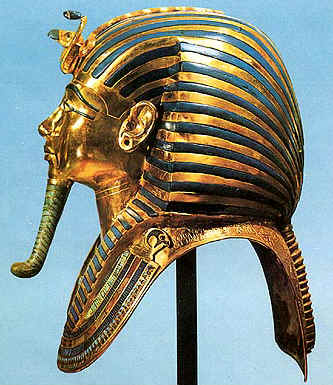It looks like you're using an Ad Blocker.
Please white-list or disable AboveTopSecret.com in your ad-blocking tool.
Thank you.
Some features of ATS will be disabled while you continue to use an ad-blocker.
14
share:
Egyptologist Nicholas Reeves of the University of Arizona was catapulted into the international news this summer when his published analysis of scans
of the walls of Tutankhamun's tomb revealed evidence of two chambers hidden behind its murals. Earlier this week, Egypt’s Antiquities minister
Mamdouh Eldamaty announced that an examination of the walls this week supports Reeve's analysis.
Reeves believes that the tomb in which Tut was discovered may have originally been the burial chamber of Tut's stepmother and wife of the monotheistic pharaoh Akhenaten, Nefertiti, whose final years and place of burial have long been the subject of much speculation.
Discovery News - King Tut's Tomb Reveals Two Secret Chambers
Yesterday at a press conference at the State Information Authority in Heliopolis, Reeves dropped yet another bombshell — the world's most iconic death mask might have been originally made for Nefertiti and not boy king! Furthermore, he's hypothesizing that as much as 80% of the grave goods discovered in Tut's tomb might actually have been Nefertiti's!
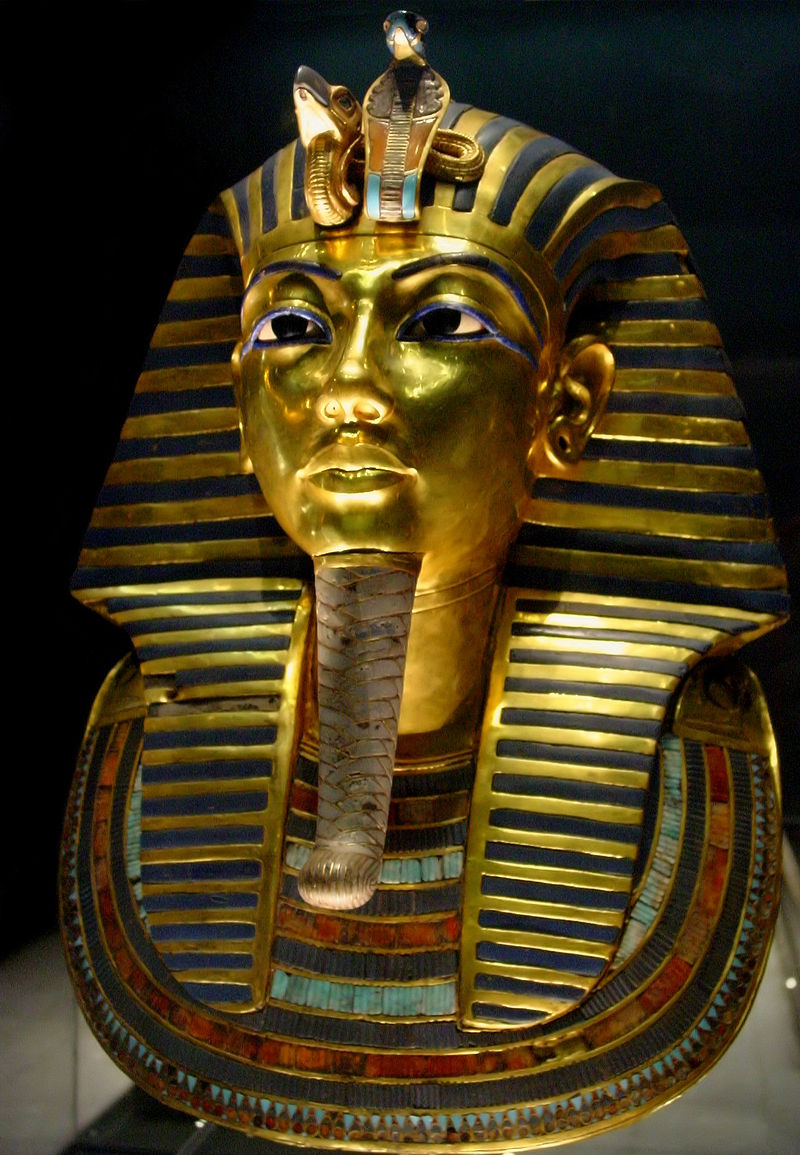 image credit Bjørn Christian Tørrissen, Wikimedia Commons
image credit Bjørn Christian Tørrissen, Wikimedia Commons
Aram Online - Tutankhamun's treasures may have originally belonged to his stepmother
Reeves believes that the tomb in which Tut was discovered may have originally been the burial chamber of Tut's stepmother and wife of the monotheistic pharaoh Akhenaten, Nefertiti, whose final years and place of burial have long been the subject of much speculation.
Discovery News - King Tut's Tomb Reveals Two Secret Chambers
He argued that a painting located behind King Tut’s sarcophagus has been wrongly interpreted. The painting shows Ay (who largely directed King Tut's reign and succeeded him) performing the Opening of the Mouth ritual on the boy king.
The figure labelled Tutankhamun would actually be Nefertiti. He noted that the lines at the corner of the figure’s mouth are a trademark in pictures of Nefertiti. On the other hand, the figure labelled Ay would be Tutankhamun, completing the death ritual for Nefertiti.
According to Reeves, the tomb of King Tut was not ready when he died unexpectedly at 19 in 1323 B.C. after having ruled a short reign of nine to 10 years. Thus he was buried in a rush in what was originally Nefertiti’s tomb, who died 10 years earlier.
Reeves told reporters the tomb’s examination revealed several unusual features, such as a contrast in the materials that cover different parts of the same wall and an extended ceiling which suggests King Tut’s tomb was originally a corridor.
Yesterday at a press conference at the State Information Authority in Heliopolis, Reeves dropped yet another bombshell — the world's most iconic death mask might have been originally made for Nefertiti and not boy king! Furthermore, he's hypothesizing that as much as 80% of the grave goods discovered in Tut's tomb might actually have been Nefertiti's!

Aram Online - Tutankhamun's treasures may have originally belonged to his stepmother
Reeves explained to Ahram Online that the gold mask was remounted years ago at the museum, allowing him to examine the back. He then realised that the face was made independently of the opposite side.
“I thought that it was very strange and may just be a technical feature.” However, he also noticed that the type of gold used for the face is different than that used on the back of the mask as well as the inlays. The eyes are in lapis while other blue portions of the mask are made from glass.
“It is very unusual,” Reeves said, adding that he then started to look at other features of the mask.
When the mask was uncovered, Reeves said, the earholes and the ears themselves “were covered with little disks of gold foil which I did not understand at first.”
With more studies, Reeves learned that ancient Egyptian kings never wore earrings. “There is no image of any ancient Egyptian king wearing earrings,” he asserted, adding that Tutankhamun did not have pierced ears but a depression that shows he wore earrings only as a child.
“But the funerary mask has holes to hang earrings,” he pointed out.
edit on 2015-10-2 by theantediluvian because: (no reason given)
a reply to: theantediluvian
I was trying to see if i could find some pictures from the inside of the mask, to see if we could agree with him, but no such luck.
I found some pics of the back and side though, which is rarely shown, we always see the front.
It's kind of interesting how this unfold, and cant wait for the result of the new search for hidden chambers to be revealed.
Reeves explained to Ahram Online that the gold mask was remounted years ago at the museum, allowing him to examine the back. He then realised that the face was made independently of the opposite side.
I was trying to see if i could find some pictures from the inside of the mask, to see if we could agree with him, but no such luck.
I found some pics of the back and side though, which is rarely shown, we always see the front.
It's kind of interesting how this unfold, and cant wait for the result of the new search for hidden chambers to be revealed.
Some follow up thoughts:
Nefertiti's appearance is attested to by another iconic Egyptian relic, a bust believed to have made by Akhenaten's official court sculptor, Thutmose, discovered along with a couple dozen plaster casts of royal faces in 1912, during excavations of what is thought to have been the artist's studio. Here's a picture of the bust from its Wikipedia page:
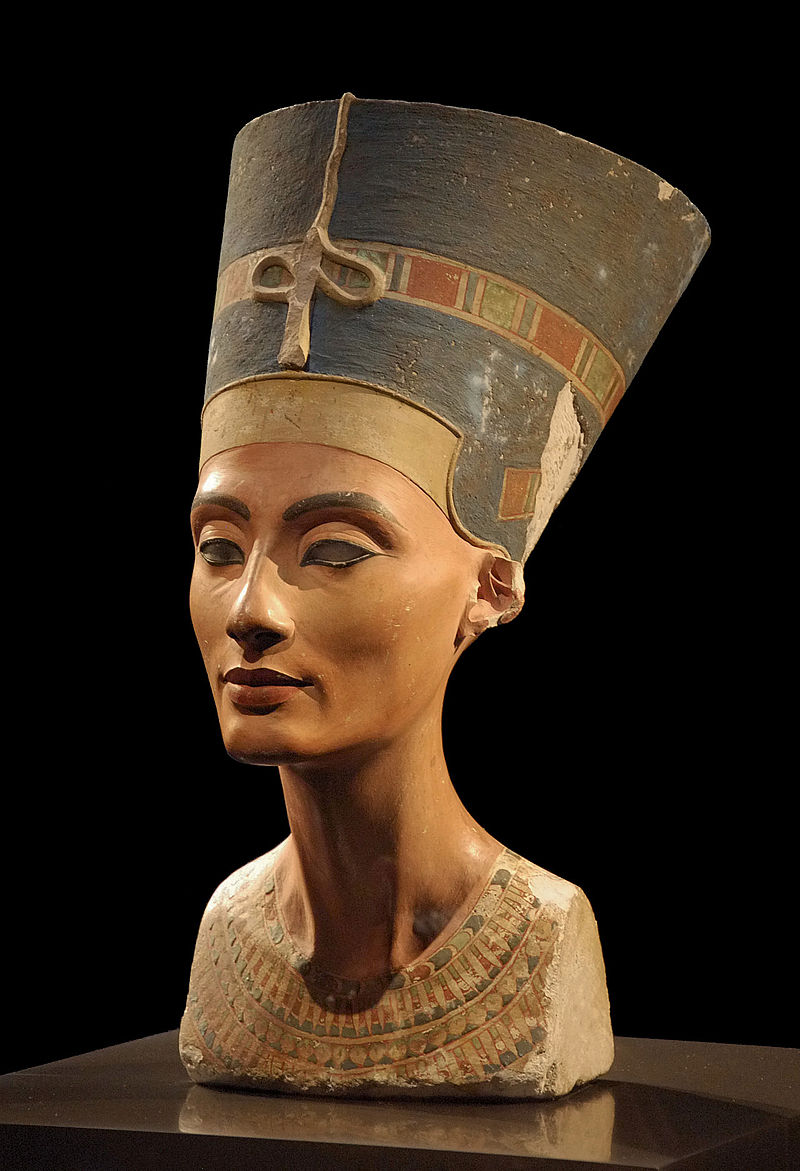
The left earlobe is missing from the bust but the right earlobe is not and its pierced (or stretched/"gauged"?). Now look at these two busts found in Tut's tomb (KV62) which have been identified as depicting Tut (images from Wikipedia - Tutankhamun)
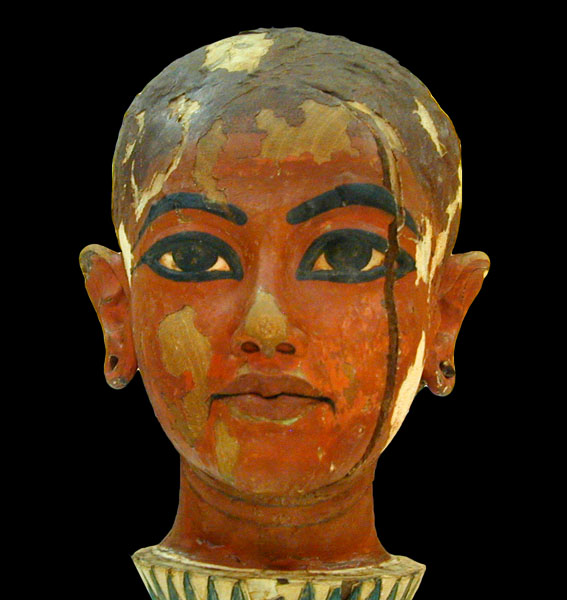
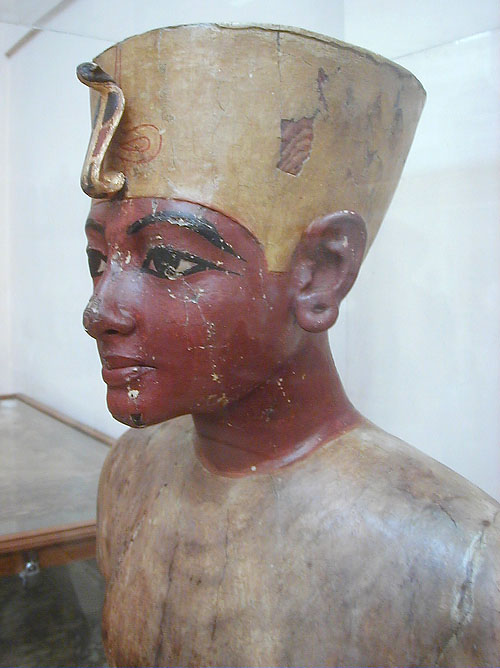
In my opinion, there are three possibilities:
1. These are busts of Tut. In which case, it looks like he had pierced ears (or stretched).
2. These are busts of Tut but they didn't start out that way.
3. These are busts of somebody else.
I'm actually leaning toward #3 myself. The bust of the head emerging from the lotus, seen from another angle here (source), this face looks distinctly female to me.
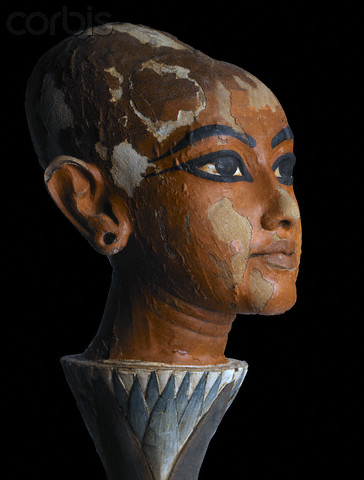
and here's a front view of the other (source:
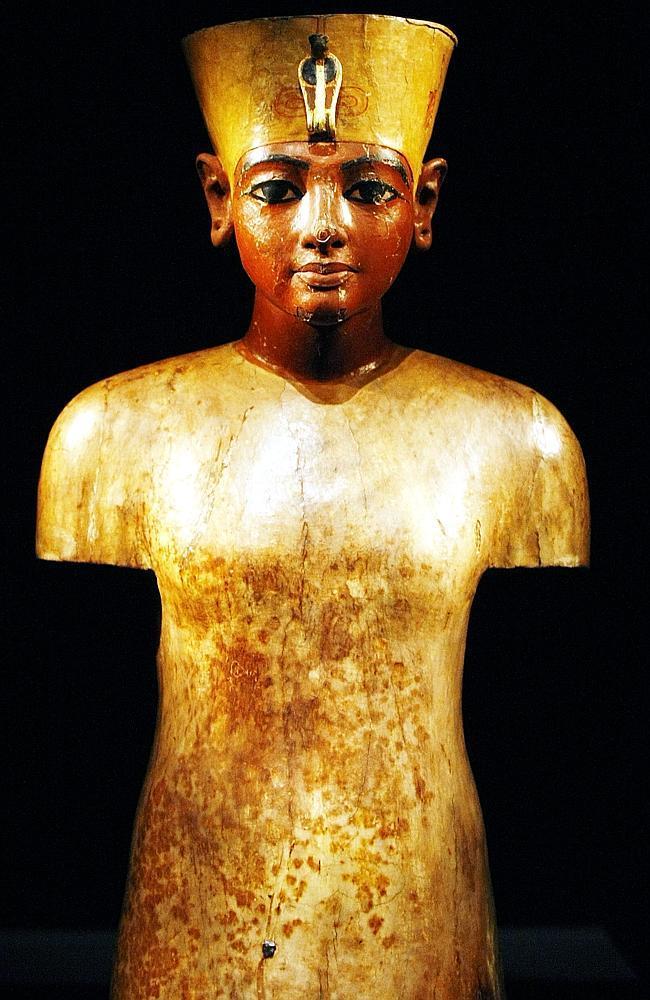
The most recent reconstructions of Tut based on scans of his remains suggest that he was not an attractive person. The sculptors of these pieces were extremely talented and they're certainly intended to be realistic depictions. The wooden busts don't particularly resemble the death mask in my opinion either. For my money, I don't think any of these were originally created as depictions of Tut tough other possibilities would be that the sculptors purposefully improved his appearance or the reconstructions are horribly inaccurate.
EDIT:
It looks like Reeve's theory about the funerary goods and mask predates his recent discoveries by some years. Here's a link to his website. An excerpt:
Nefertiti's appearance is attested to by another iconic Egyptian relic, a bust believed to have made by Akhenaten's official court sculptor, Thutmose, discovered along with a couple dozen plaster casts of royal faces in 1912, during excavations of what is thought to have been the artist's studio. Here's a picture of the bust from its Wikipedia page:

The left earlobe is missing from the bust but the right earlobe is not and its pierced (or stretched/"gauged"?). Now look at these two busts found in Tut's tomb (KV62) which have been identified as depicting Tut (images from Wikipedia - Tutankhamun)


In my opinion, there are three possibilities:
1. These are busts of Tut. In which case, it looks like he had pierced ears (or stretched).
2. These are busts of Tut but they didn't start out that way.
3. These are busts of somebody else.
I'm actually leaning toward #3 myself. The bust of the head emerging from the lotus, seen from another angle here (source), this face looks distinctly female to me.

and here's a front view of the other (source:

The most recent reconstructions of Tut based on scans of his remains suggest that he was not an attractive person. The sculptors of these pieces were extremely talented and they're certainly intended to be realistic depictions. The wooden busts don't particularly resemble the death mask in my opinion either. For my money, I don't think any of these were originally created as depictions of Tut tough other possibilities would be that the sculptors purposefully improved his appearance or the reconstructions are horribly inaccurate.
EDIT:
It looks like Reeve's theory about the funerary goods and mask predates his recent discoveries by some years. Here's a link to his website. An excerpt:
Several other spectacular items from Tutakhamun’s tomb bear legible cartouches with Nefertiti’s name overlaid by that of the dead king, including the miniature coffins used to enshrine his viscera. Numerous other objects were clearly made for a different intended deceased, and were pressed into service when Tutankhamun died unexpectedly.
edit on 2015-10-2 by theantediluvian because: (no reason given)
Then what's up with the braided goatee?
"Yo Skrill, what about Neffy?"
"It's a Man, baby Yeah!"
"Yo Skrill, what about Neffy?"
"It's a Man, baby Yeah!"
a reply to: kissy princess
Wasn't attached very well
Remember this news item from January of this year?
Beard on King Tut’s Mask Snapped Off, Glued Back On
Wasn't attached very well
Remember this news item from January of this year?
Beard on King Tut’s Mask Snapped Off, Glued Back On
a reply to: theantediluvian
Correct me if I am wrong, but did not Tutahnkamun reject his father's Monothesism?
Akhenaten was practically erased from all official monuments and such, I could see the fledgling boy king's court also usurping his mothers tomb and grave goods in an effort legitimize his reign and delegitimize his parents.
One thing for sure, these objects are a testament to the skills of the Egyptian artisans.
Even though Tut and family were much later than the pyramids, the skill of the artisans in that period was just as impressive, and people still question that they built those grand tombs.
Correct me if I am wrong, but did not Tutahnkamun reject his father's Monothesism?
Akhenaten was practically erased from all official monuments and such, I could see the fledgling boy king's court also usurping his mothers tomb and grave goods in an effort legitimize his reign and delegitimize his parents.
One thing for sure, these objects are a testament to the skills of the Egyptian artisans.
Even though Tut and family were much later than the pyramids, the skill of the artisans in that period was just as impressive, and people still question that they built those grand tombs.
a reply to: theantediluvian
I was just recently reading about Tut. The author commented more than
once that his appearance was feminine or androgynous but attributed
that to his being born from what we would consider incest today.
I was just recently reading about Tut. The author commented more than
once that his appearance was feminine or androgynous but attributed
that to his being born from what we would consider incest today.
a reply to: kissy princess
Eqyptian ruling queens wore ceremonial artificial beards - www.touregypt.net...
Eqyptian ruling queens wore ceremonial artificial beards - www.touregypt.net...
This is nonsense, the Mask has conclusively been shown to be a good representation of who it was covering
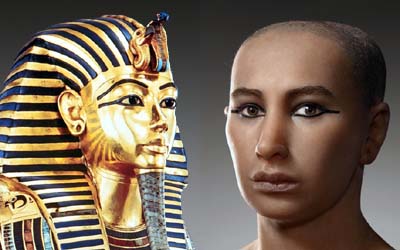

originally posted by: bigfatfurrytexan
a reply to: Marduk
i think what is being said is that the original mask was repurposed, not simply reused.
I know what's being said, but its still nonsense, a lot of Tuts grave goods are known to have originally been reserved for Smenkhkare, but the Mask has his face on it,
If Nicholas Reeves continues to make unsupportable claims like this, he will be kissing goodbye to any work in Egypt. The Egyptian antiquities commission takes a dim view of this sort of thing
new topics
-
Dr Cambell talking about using worm meds for cancer
Medical Issues & Conspiracies: 2 hours ago -
A Question for You on the Left
Political Ideology: 4 hours ago -
Words of Wisdom from the Dear Leader - Transcribed for the World
Regional Politics: 4 hours ago -
Looks like Biden kicked off WWIII and Putin threatening nukes to retaliate
World War Three: 5 hours ago -
Watch SpaceX Starship Test Flight 6 Live - Launch Starts 4pm CST , 2200 GMT.
Space Exploration: 9 hours ago -
Watch Dramatic Moment Ukrainian Nursery Teacher Takes Out Russian Missile With Rocket Launcher
Mainstream News: 10 hours ago
top topics
-
A Question for You on the Left
Political Ideology: 4 hours ago, 13 flags -
Looks like Biden kicked off WWIII and Putin threatening nukes to retaliate
World War Three: 5 hours ago, 9 flags -
Dr Cambell talking about using worm meds for cancer
Medical Issues & Conspiracies: 2 hours ago, 9 flags -
He Had and It Has
Short Stories: 14 hours ago, 5 flags -
Words of Wisdom from the Dear Leader - Transcribed for the World
Regional Politics: 4 hours ago, 4 flags -
Morning’s Reverie
Short Stories: 16 hours ago, 3 flags -
Watch SpaceX Starship Test Flight 6 Live - Launch Starts 4pm CST , 2200 GMT.
Space Exploration: 9 hours ago, 3 flags -
Watch Dramatic Moment Ukrainian Nursery Teacher Takes Out Russian Missile With Rocket Launcher
Mainstream News: 10 hours ago, 2 flags
active topics
-
A Question for You on the Left
Political Ideology • 25 • : KrustyKrab -
The Reactionary Conspiracy 13. The plot’s theology.
General Conspiracies • 304 • : Oldcarpy2 -
DefCon Teetering on Escalation
World War Three • 35 • : marg6043 -
Watch Dramatic Moment Ukrainian Nursery Teacher Takes Out Russian Missile With Rocket Launcher
Mainstream News • 29 • : Lazy88 -
Incoming TRUMP Admin will Declare a National Emergency to Mass Deport People Here Illegally.
Social Issues and Civil Unrest • 107 • : peter_kandra -
Democrat county officials openly declare intention to commit ballot fraud in PA
2024 Elections • 16 • : YourFaceAgain -
The Final Experiment is Scheduled for December 2024. Will it Finally Answer the Question?
Science & Technology • 23 • : Arbitrageur -
Trump’s N.Y. hush money sentencing delayed until after Nov. election
2024 Elections • 21 • : xuenchen -
He Had and It Has
Short Stories • 6 • : Moon68 -
-@TH3WH17ERABB17- -Q- ---TIME TO SHOW THE WORLD--- -Part- --44--
Dissecting Disinformation • 3309 • : Thoughtful3
14

